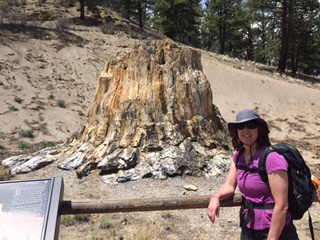
As someone who worked as a Park Ranger with the National Park Service for 17 years, I’ve grown to appreciate the many NPS sites around the country. Some are considered the “crown jewels” and are visited by millions of visitors every year, and some are small unassuming sites with just a few thousand who come. But the one thing I’ve never doubted is that each is worth preserving by the Park Service, to keep it sacred, to tell its story of what merits it being preserved.
Today I walked around what seemed like an ordinary high mountain valley just west of Colorado Springs. Driving through on County Road 1, staring at the brown grasses dotted with an occasional Ponderosa Pine, I really didn’t understand what made this place special. But I’d always wanted to visit all the National Park sites in Colorado, and so far this one had evaded me.
And so it is, on my birthday, I find myself wandering around a dirt trail, reading signs telling me that 34 million years ago, this dry mountain valley was under water, part of a huge lake. And that lake was surrounded by a lush forest filled with poplar trees, beech trees, and insects of all kinds — an environment that seemed more fitting to places back east than anything you would see in Colorado. Though I stared at the sketches of this scene, complete with rhinoceros-like creatures and dragonflies, looking all the while like some lush swampland, I couldn’t quite get myself to believe this story.
That is, until my husband and I took a stroll along the 1-mile loop out the back door of the visitor center at Florissant Fossil Beds National Monument. Because all along this loop were gigantic stumps. Petrified stumps of Redwood trees that grew here millions of years ago and were preserved now as stone. The diameter of the stumps was 10 feet or more across — I could only imagine the size of the tree that had grown from it.
Even the rings of the tree were intact, showing that these trees were several hundred years old before they tumbled down, a victim of a changing climate and changing environment. They looked so life-like, so like wood, that I had a hard time realizing they had become permineralized, a term I had never heard before today. Though the fencing around the stumps made me think otherwise, I wanted nothing more than to touch them, just to make sure they were in fact turned to stone.
Apparently, others from long ago had the same thoughts, as witnessed by the saw blades stuck in the stumps where tourists from the 1800s had tried to cut the petrified wood. As we finished walking the trail, I read of tourists from over 100 years ago, collecting petrified wood, and ransacking the landscape of the remnants of this long ago time. It made me sad to think of how they had robbed others of enjoying this monument today. I’m sure if the stumps hadn’t been stuck into the ground, they would have taken them too.
And yet at the same time, I felt appreciative once again of the National Park Service. Though this particular monument may not get visited by a fraction of the visitors that go to Rocky Mountain National Park, it too is deserving of preservation and stewardship. What a miracle to see the remnants of fossils, to see the stories that the rocks can tell. And gratitude for those who lobbied hard to prevent development back in the 1960s, so that it could be preserved as a national monument. Because that is what the National Park Service is all about.

